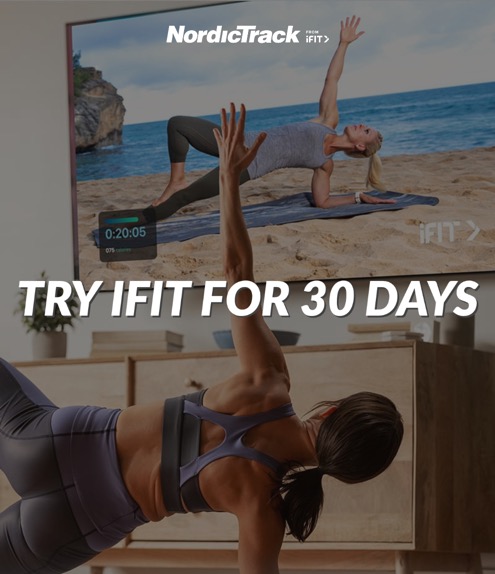
If knee pain, osteoarthritis, or a past injury has made traditional workouts feel risky, you’re not alone—and you’re not out of options. Low-impact cardio can help you maintain fitness while protecting sensitive joints, and in many rehab settings it’s the preferred on-ramp back to consistent movement¹. For readers specifically seeking the best cardio machine for bad knees or knee rehabilitation, a recumbent bike remains a top pick, but it’s worth comparing it against treadmills, ellipticals, and rowers so you can choose the machine that truly fits your needs.
Quick compare before you decide:
See side-by-side pros/cons in Compare cardio machines
Considering a bike for rehab? Explore the NordicTrack 10 Recumbent Bike, which offers comfort and adjustable features that may align with preferences for low-impact cardio.
Why Low-Impact Makes The Best Cardio Machine for Bad Knees
Clinicians often recommend cycling or elliptical training as alternatives to running or brisk, high-impact walking because these modes reduce repetitive joint loading while preserving a rhythmic, gait-like pattern of movement¹. In clinical populations, adding stationary cycling to standard therapy improved balance and gait more than therapy alone—evidence that the pattern is not only gentle but also functionally meaningful². Over the long term, people who bicycle are less likely to report frequent knee pain and symptomatic knee osteoarthritis, with a clear dose–response across life stages³.
Exercise Bike vs. Other Cardio Machines
Below is a research-driven comparison of popular modalities. Where helpful, we’ve included what the evidence suggests about load, activation, and adaptation so you can pick the path that matches your current tolerance and goals.
Treadmills (flat and body-weight support)
What the evidence says: Walking is foundational for mobility, but even at moderate intensity it drives higher tibialis anterior and gastrocnemius activation than recumbent cycling—great for lower-leg strength, but sometimes provocative for irritated knees or ankles¹. In knee osteoarthritis, a randomized trial using a lower-body positive pressure (LBPP) treadmill—which offloads a controlled percentage of body weight—showed greater gains in walking speed, stride length, and knee range of motion versus conventional over-ground walking, alongside larger pain reductions⁴.
When it’s a match: You want to maintain weight-bearing capacity and practice real-world walking, but you need an off-ramp (like LBPP or very conservative speeds/grades) to keep symptoms quiet⁴.
Watch-outs: Higher anterior tibialis and calf demands vs. recumbent cycling can flare some conditions; start flat, slow, and short to assess tolerance¹.
Helpful reads: Ellipticals vs Treadmills, Good Incline to Walk On A Treadmill To Lose Weight, and Treadmill FAQs.
Ellipticals
What the evidence says: Ellipticals mimic a running-like motion with reduced impact and often feel smoother than jogging¹. However, controlled biomechanical analyses show ellipticals can induce higher knee joint torques than stationary bikes, with peaks occurring later in the “pedal” cycle; higher cadence further increases vertical loads at the knee and ankle, especially on fixed-pedal designs that restrict ankle motion and may drive inward rotation⁵.
When it’s a match: You want a weight-bearing, whole-leg stimulus with a smooth feel, and you tolerate modest knee torques well—particularly at moderate cadence⁵.
Watch-outs: At high speeds, peak forces and torques rise; a fixed foot platform can nudge the knee toward internal rotation.⁵
Helpful Reads: Great Workout On The Elliptical and Ellipticals vs Treadmills.
Rowing machines
What the evidence says: Rowers deliver exceptional cardiorespiratory work with substantial posterior-chain involvement. Still, repeated knee flexion under load may aggravate symptoms in early rehab—especially if range is limited or if anterior knee pain is prominent¹. While rowing can be an excellent later-stage choice for comprehensive conditioning, most knee-rehab protocols begin with gentler, more controllable ranges and loads—which is where cycling shines².
When it’s a match: You’re past the most irritable phase, tolerate deeper knee flexion, and want total-body conditioning with careful technique¹.
Watch-outs: Technique matters; if pain increases during the catch (deep flexion), regress range and emphasize cycling or walking first¹.
Helpful Read: How To Use A Rowing Machine Correctly.
Upright vs. Recumbent Exercise Bikes
What the evidence says: Stationary cycling—upright or recumbent—reduces impact while preserving the reciprocal flexion/extension pattern essential for gait². Compared with upright cycling and treadmill walking, recumbent cycling produces lower lateral gastrocnemius and tibialis anterior activation at matched moderate intensity—often perceived as easier on the ankle/calf complex and, by extension, more tolerable for sensitive knees¹. Upright cycling shows the highest calf activation among the tested devices in one lab comparison¹. Over decades, people who bicycled across more life stages exhibited less frequent knee pain and symptomatic radiographic OA, suggesting a knee-friendly trajectory when cycling becomes a habit³.
When it’s a match: You want the most controllable, joint-gentle progression with an easy start point and granular resistance steps¹.
Watch-outs: Seat/crank fit and resistance ramps still matter. Keep cadence and resistance conservative at first to avoid patellofemoral irritation⁵.
Helpful Read: Compare Cardio Machines.
Relative Knee Joint Stress by Cardio Machine
| Cardio Machine | Relative Knee Stress | Key Considerations |
| Recumbent Bike | Lowest | Supportive seat, reduced calf/ankle demand, joint-friendly¹ |
| Treadmill (LBPP) | Reduced (with body-weight support) | Improves gait mechanics, lowers pain in knee OA patients⁴ |
| Elliptical | Moderate | Smooth, low-impact, but higher torque at certain angles⁵ |
| Rowing Machine | Higher flexion demand | Great conditioning, but deep knee bend can aggravate pain¹ |
This chart compares common cardio equipment to see which is the best cardio machine for bad knees. Recumbent bikes typically place the least stress on sensitive knees, while treadmills with body-weight support offer a middle ground. Ellipticals and rowers provide great conditioning but may demand more from the joint at certain angles.
Why A Recumbent Bike Is Often The Best Cardio Machine For Bad Knees

Because the seat is supportive and the pedals are out in front of you, a recumbent bike lets you cycle with less ankle/calf demand and less need for balance—two big wins when knees are cranky¹. Compared with treadmill walking, recumbent cycling tends to reduce activation of tibialis anterior (a common hotspot with anterior knee pain) and the lateral gastrocnemius, helping many users tolerate longer sessions earlier¹. Add in the gait-like reciprocal motion and strong rehab evidence for cycling’s impact on balance/gait, and the case becomes compelling² that it rules as the best cardio machine for bad knees.
The NordicTrack 10 Recumbent Bike features a step-through frame, cushioned seat, and adjustable resistance levels designed for user comfort and workout flexibility.
Explore the NordicTrack 10 Recumbent Bike to build a consistent cardio routine using a low-impact format.
Programming Basics: Build A Knee-Friendly Cycling Plan
- Start easy: 10–15 minutes, low resistance, conversational cadence¹.
- Prioritize smoothness: Focus on circular pedaling and posture².
- Progress patiently: Add 5 minutes per week and 1–2 resistance levels only when pain stays ≤2/10 during and after².
- Cross-train wisely: When symptoms allow, layer short, flat walking bouts; consider gentle elliptical as tolerated⁵.
- Think long term: Consistent cycling is associated with less knee pain and lower symptomatic OA prevalence³.
Want more structure? iFIT’s personalized training plans automatically adjust intensity through SmartAdjust and give you coach-led workouts that evolve as you do.
Try iFIT’s Personalized Training to stay accountable and safe.
Where Other Machines Still Fit
- LBPP treadmill sessions let you practice true walking mechanics with less joint load⁴.
- Elliptical at moderate cadence can be a good variety day if torque-heavy deep angles don’t aggravate symptoms⁵.
- Rowing becomes a potent full-body option once knee flexion tolerance improves¹.
See how modalities stack up in Compare Cardio Machines.
Bottom line
For bad knees, the most forgiving starting point, supported by muscle-activation data, rehab outcomes, and long-term epidemiology, is recumbent cycling¹. Ellipticals and treadmills remain valuable tools, particularly with body-weight support on treadmills, but when minimizing knee torque and distal-leg demand is the priority, a recumbent bike paired with structured guidance is hard to beat. The NordicTrack 10 Recumbent Bike, combined with iFIT programming, provides adjustable resistance and guided workouts that support a gradual approach to building cardio fitness.
Explore More Training Ideas While You Rebuild Capacity:
FAQ: Cardio Machine for Bad Knees
Yes. Compared with walking, ergometer cycling typically yields smaller lower-limb joint loads¹.
Recumbent positioning typically reduces strain on the ankle and calf compared to upright bikes or treadmill walking, which some users find more comfortable for longer sessions¹.
In chronic stroke patients, adding stationary cycling improved balance (BBS), mobility (TUG), and gait speed (10MWT)².
They’re lower impact than running, but lab work shows higher knee torques than stationary bikes⁵.
LBPP treadmills improved gait speed, stride length, knee ROM, and pain versus ground walking in knee OA⁴.
It can be, but deep flexion under load may aggravate some conditions early on¹.
Aim 3–5x/week. Begin with 10–15 minutes at low resistance/cadence and build gradually².
Population data link bicycling with lower prevalence of frequent knee pain and symptomatic radiographic OA³.
Upright activates calves more; recumbent lowers distal-leg demand and is often better tolerated¹.
SmartAdjust auto-scales resistance, Follow-Trainer controls reduce fiddling, and structured programming supports consistent progression².
References
- Bouillon L, Baker R, Gibson C, et al. Comparison of Trunk and Lower Extremity Muscle Activity Among Four Stationary Equipment Devices: Upright Bike, Recumbent Bike, Treadmill, and ElliptiGO®.
- Kim S, Cho H, Kim YL, Lee S. Effects of Stationary Cycling Exercise on the Balance and Gait Abilities of Chronic Stroke Patients.
- Lo GH, Richard MJ, Kriska AM, et al. Bicycling over a Lifetime Is Associated with Less Symptomatic Knee Osteoarthritis: Data from the Osteoarthritis Initiative.
- Chen H-X, Zhan Y-X, Ou H-N, et al. Effects of Lower Body Positive Pressure Treadmill on Functional Improvement in Knee Osteoarthritis: A Randomized Clinical Trial Study.
- He M-Y, Lo H-P, Chen W-H. Effects of Stationary Bikes and Elliptical Machines on Knee Joint Kinematics during Exercise.
Disclaimer: The primary purpose of this blog post is to inform and entertain. Nothing on the post constitutes or is intended to be a substitute for professional medical advice, prevention, diagnosis, or treatment. Reliance on any information provided on the blog is solely at your own risk. Always seek the advice of your physician or other qualified health provider with any questions you may have regarding a medical condition, and please consult your doctor or other health care provider before making any changes to your diet, sleep methods, daily activity, or fitness routine. Do not disregard professional medical advice or delay seeking it because of information available on this blog. NordicTrack assumes no responsibility for any personal injury or damage sustained by any recommendations, opinions, or advice given in this article. Always follow the safety precautions included in the owner’s manual of your fitness equipment.


